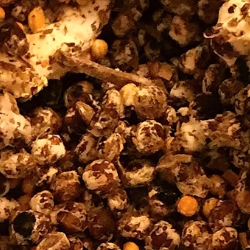
“You can use cardboard,” she instructed five fellow students, “newspaper, straw, a bunch of different things.” But tonight the fiber of choice was toilet paper, which they dunked in boiling water, then smeared with spores from a mail-order kit and tied in plastic bags. After a couple of weeks in an appropriately dark corner, Hare said, edible oyster mushrooms would begin to grow.
Hare is founder and president of the Mycology Club, among the newest of Amherst’s nearly 150 student-run organizations. Every year, students present ideas for new clubs to Paul Gallegos, director of student activities, and if the proposals are well-researched and demonstrate passion and follow-through, he says, the College will help provide the space and funding to bring them to life.
Hare is the daughter and granddaughter of mushroom foragers, members of the New York Mycological Society. When she discovered that Amherst had no similar club, she approached Gallegos about starting one. Her interest mushroomed, one might say, as she researched a paper on the use of fungi to remediate polluted soil. This work was for the course “The Resilient (?) Earth: An Introduction to Environmental Studies,” taught by Assistant Professor Ashwin Ravikumar. Hare went on to grow mushrooms in her dorm room, thanks to a dearth of windows and a forgiving roommate. (“It smells a little bit,” Hare admits, “but it doesn’t really stink up a room.”) She also made the acquaintance of Willie Crosby, a local commercial grower, who provided tips on foraging and cultivating.
Every new club at Amherst has to come up with a constitution, with clauses such as those forbidding discrimination and hazing. Gallegos and his colleagues are now exploring ways to more actively involve students in approving new clubs. The College is also expanding the support network for club leaders like Hare, including through workshops with Jelani Johnson, associate director of student activities.
Meanwhile, Hare and her fellow club members continue to cultivate and identify mushrooms. “The mycelium is under our feet right now,” she said at another recent meeting, as four students walked through the College’s Wildlife Sanctuary in the darkening twilight, searching for the white webbing of fungal filaments and stalks. “Trees are able to pass nutrients through the mycelium to the different species of trees. Mycelium is huge. It can span for miles.”
Photo by Bill Sweet